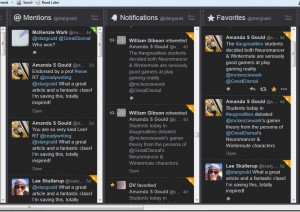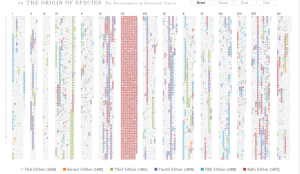Mckenzie Wark first presented his Gamer Theory online in form of flashcards, wherein readers commented and contended and Wark replied. Then Harvard University Press turned the Theory into the dead-tree version that incorporates all the marginal comments as footnotes. Arguably the affordance should only change what we are seeing, i.e. a computer screen or pieces of paper. The digital version of the Theory, however, appeals to me more in various aspects than the physical book, or a pdf scanning of the book.
The flashcards online itself makes the reading experience less painful because they segment the book into several chapters and further into 5-flashcard groups within each chapter. Navigation through the flashcards also expedites the reader’s journey in the Gamer Theory. The search function, were it able to function properly, would help the reader to find keywords and main ideas. Of course, readers can also exchange their opinions of the Theory on the margin of the webpage. On the other hand, the printed version of the book (or a scanned pdf) takes away all these features and is just utterly boring to read.
The theory itself, however, does not come along deep or practical, in the first two chapters at least. The Theory draws a close analogy between game space and human lives, which sounds fanatical to begin with and superficial/ill-purpose in actuality. Why would someone think that our life is a game anyway? Wark started the Theory with Plato’s Cave Allegory that challenges the common view on the nature of reality. If cavemen were tied up and forced to see only one side of the cave from the day they were born, their reality would only contain the shadows on the wall and the echoes whose sources are mistakenly thought to be the shadows. The example implies that our reality cannot be some objective world happening outside but precisely our perceptions of it. Wark then moved on to describe Benjamin’s Sims world (a game) that in various ways resembles our world (the gamespace), but of course the fact that Sim is a life simulation game predicates the resemblance and the allegory; other games may not carry the allegory at all.
The reason why the Plato’s allegory of cavemen works is because Plato himself notoriously endorsed the ideal world, the perfect world afterlife, and physical existence of the perfect abstract objects. Plato alleged that our world is a failed version of the perfect world; not surprisingly, what’s in parallel in the author’s argument is that the world is actually an imperfect game play. Admittedly, it is hard to argue against idealism because our senses channel in the information from the outside and our inner ideas evolve to be more capable in the so-called mental world than our physical body in the outside world because our ideas can predict the physicals and we can think that we know it. We think that we know what games are and that we know what constitute reality. We can also think that our life magically resembles a game like Wark does. We make all these silly analogies because we can, not because it is ever for a second true. Nevertheless, we can also remind ourselves that it is life that generates all kinds of games and that it is we human who create all the games that have ever existed. Playing a word game cannot reverse the relation of game and life. I agree that epistemically we cannot question whether there exists a larger entity than the life as we know it; but the argument that says we should live life according to the perfect game rules that are, in fact, produced by, in, and from the imperfect life is simply malarkey.
Living a life as a game leads us to nowhere, if not to fatalist exasperation. Honestly, what game in the world can get as a millionth complicated as the life on earth (not to mention what happen in the outer space capable of destroying everything we know)? Since no such game exists, what game rules and what algorithms are there for us to follow? All the games oversimplify our real lives and that’s partially why people escape from the actual, complex life to the simplified virtual world wherein there are no hard problems and people to deal with. The most complex algorithms written to generate the game almost have nothing to do how the gamers win the game. A game that asks the gamer to modify its own code to win the game does not attract any gamer at all; rather, a game that asks me to earn money and survive in a war to win the game does. Because earning and surviving operate at a level way above the perfect algorithms running in the kernel, nobody would bother to decode the algorithm of this life and then abide by the code. It is like saying we should abide by the principle of quantum mechanics to live a life, which actually sounds much more reliable than the Game Theory. Treating life as a game doesn’t benefit us in any way.
At some point, the author mentioned that some gamers focus more on following the rules and winning but other gamers focus more on the items, or as I call the byproducts/side-effects of the game, such as collecting the furniture in Sims. This more or less jibes with a certain part of our life, but not entirely. For example, I myself value the experience of things, but I also like things themselves. So what would be the winner of my life – the Cathy who has more experience or the Cathy who has more possessions, prizes and good grades? They both die one day for sure. Or actually the Cathy who lives longer? Who is there to tell me the rules of this life? (I am a hundred percent serious but the premises of the Theory now just read like jokes.) There are other problems with the analogy such as the relationship between the gamer and the Sim’s character. Is Cathy both the gamer and the character? If the character cannot know there is a gamer, will the gamer know that the character can know this (have consciousness)? [The introduction of the Bogost’s How to Do Things with Videogames explicates lots of problems with the Gamer Theory]
At last, the comments at the margins are not peer reviews because the author did not revise the content accordingly (not that I know of) but simply inserted them as footnotes. Academic peer reviewers must review the content carefully and give the author constructive suggestions; only after the author revises accordingly or defends herself can the content being reviewed again and so forth until finally published. Comments do not serve these purposes. The book might have undergone some real peer reviews before publishing but the discussion section beside the flashcards cannot be counted as peer reviews.



